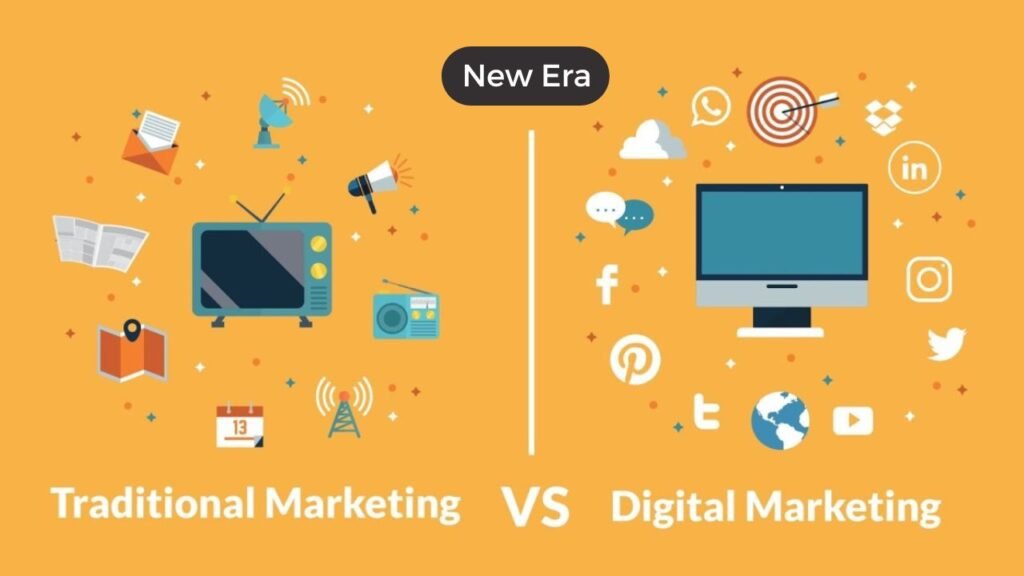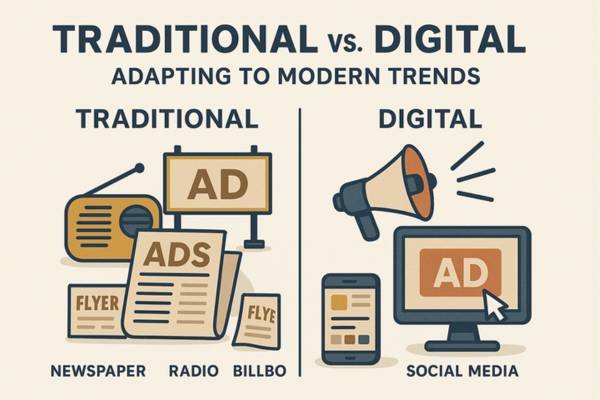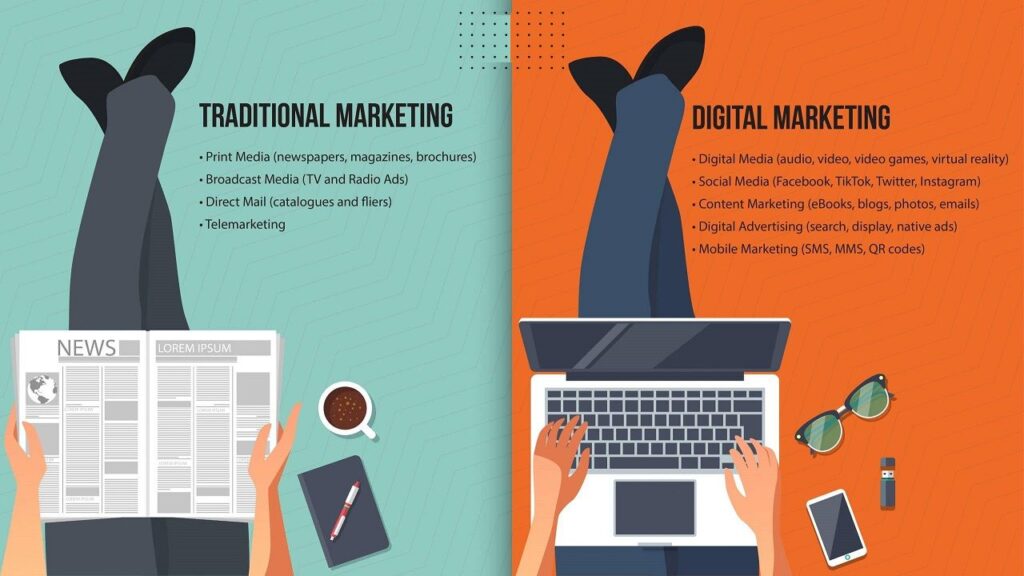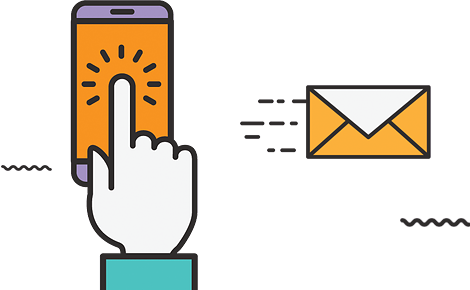
With the constant changes happening in advertising, companies need to make an important choice. You have to choose between using traditional methods and accepting the new way of digital marketing. Using either method of advertising can work, but staying up-to-date is the best way to stay ahead of competitors. I’ll look into how advertising, whether offline or online, is often quiet and has its benefits and risks. I also teach you how to use both Traditional vs Digital Advertising types together effectively.
Identifying the Biggest Benefit: Traditional vs Digital Advertising in the Climate
To win over new customers, companies have hit a critical point in the way they operate: Use traditional ways of advertising or start using digital techniques, both are different, but I’ll disclose traditional vs digital advertising, which is better in today’s era, since the sky might be the limit here. You should know how to take advantage of each, since this helps you communicate with the right group.

Hey Guys, I am Javed Akhtar, a Digital Marketing Professional from Delhi with over 10 years of experience across industries like IT, E-commerce, Real Estate, Travel, and B2B Market from having worked with good brands and startups also, and my location is Delhi, Dubai, UAE. I’ve built a career around helping businesses grow exponentially and smoothly, and not just online, but in the minds of their audience. Today I am explaining about Traditional vs Digital Advertising.
Through my journey in Digital Marketing, Social Media Management, Video Editing, Graphic Designing, Prompt Engineering, and Business Automation, I’ve learned one of the most powerful truths is “Great Marketing isn’t about manipulation or shortcuts – but it’s all about Clarity, Strategies, Creativity, Consistency, Value, and Execution”
That’s why I started Business Promotion 24 – “Transforming the Future with Digital Innovation & Execution” A Platform Dedicated to educating students, working professionals, creators, business owners with real, reliable, and practical knowledge, where it’s blogging, useful tips, YouTube tutorials, social media guides, I’m here to share insights that works – no fluff, no shortcuts, just honest and right informational strategies and Opinion. If you’re tired of misleading content and want to learn how to genuinely grow your brand and skillset online, you’re in the right place. Let’s build a smarter digital future together. Now I am going to explain today’s topic is “Traditional vs Digital Advertising Adapting to Modern Trends”.
Introduction
Traditional advertising has lasted for many years and has been shown to work. Newspaper, billboard, and radio ads have caught the attention of people for many decades. The simple format of these media leads to them becoming accessible to more potential customers, making them a good match for reaching a local market. Geography is a barrier, and it can be hard to track the return on these types of advertisements.
Traditional Advertising
Using traditional advertising has been done for a long time and remains in use today. For years, advertisers have relied on these methods to get their message across to the public. Since these media are simple to use, they can be seen by many people, including those who are not tech-savvy. At the same time, geography limits their opportunities, and many times, it is hard to measure how well these methods perform.
Online Advertising: A World Full of Opportunities
Traditional ways of marketing were replaced by digital marketing. Social media, the internet, and search engines all give us the resources to reach particular groups with great accuracy. The use of active voice and interactive tools, video, and clickable CTAs helps create a spark for the imagination of everyone. Keeping an eye on users and gathering data enables businesses to adjust their strategies as they go, whether in traditional vs digital advertising.
- Adaptation to New Trends: Personalization and Targeting. In the age we live in now, using first-person language is a must. Using Data Analytics, businesses can provide each customer with their tailor-made content. Today, with online advertising, I can advertise to people based on things such as their interests, age, and what they usually do, ensuring the right people receive our message.
- Using interactivity in ads is the heart of successful advertising. Use interactive content to bring the audience on board by letting them take quizzes, take part in polls, and engage with interactive videos. Following this method helps people relate more to the brand, share their thoughts, and stick with it for a longer period.
- Data-Driven Decision Making. Advertisers’ use of data has transformed advertising. With digital media, one can see exactly how many clicks, impressions, and conversions there are, revealing information about customers’ behavior. Having real-time data makes it possible to rapidly tune up your campaign so you are focusing your resources on what performs best.
- Consumers use different channels and expect the brand experience to be consistent for everyone. Ads smooth out any gaps and ensure customers are engaged no matter what type of channel they use (billboard, website, social media ad).
- Between these two forms of advertising, there is a chance to reach the best results: synergy. It is better for businesses to use both strengths together than to play one against the other. A strong traditional ad can bring people online for further and deeper engagement. Using QR codes and hashtags connects them easily, ensuring a smooth transition between them.
Navigating the Crossroads Ad Landscape
When it comes to advertising, the two companies are shining as leaders now. Using marketing by print and the internet. Because there are strengths and weaknesses in each, you must see how they adapt to sudden shifts in the market and customers’ preferences.
Timeless Marketing: A Reason to Look Forward to the Future
Before the Age of Pixels

The Rise of Digital Advertising
The Development of Internet Advertising
There’s something about the old pro’s approach to advertising that has an old-fashioned style that’s hard to ignore. The touchable nature of print, the bigger-than-life billboards, and the music stuck in your head help give these ads a warmth that digital can sometimes lack. Mainly old people and the new generation discussed traditional vs digital advertising, but the truth is that the new generation is adopting, while old people are not. Here I am sharing a brief article about this, click here
Does the world we live in make traditional advertising less attractive? The draw is the way it allows older people, or those not as skilled with technology, to join in. Always keep in mind the possibilities of reaching people who are not connected to social media.
Digital Advertising: Where Precision and Innovation Intersect
The Digital Wave: Riding
On the other hand, digital advertising uses new technology and accurate data to target its users. Since every action, scroll, and click leaves a trace online, advertisers now have a vast amount of data to work with. Both measurement and participation play a key role in the world of digital advertising, whether through social media ads or banners that people can take part in.
Now, switching between different web platforms is much easier than ever. So, companies may only need one website, a social media presence, and an app to cover their online needs. Is this at a price? We look at the possible problems that might come with a digital focus.
The two types of synthesis work together in harmony.
Nowadays, thanks to this mix of habits, you might run into people who like to physically hold a newspaper but also use apps to read the news. It is becoming clear to advertisers that the best part of both channels comes from their union.
The Ultimate Battle: Recognizing Contemporary Trends
Being flexible is now more important than ever in marketing, thanks to the constant changes brought by technology. It is here that the market really sorts out which strategy will still work, because fashion is always changing.
Digital’s ace card: data analytics and personalization
Thanks to big data, digital ads can reach people on a much more personal level. When brands add personalized content to their offerings, it allows consumers to feel emotionally connected to the brand. Receiving personalized email offers with products you have been searching for online is an example of what digital advertising can do that traditional ads rarely can. There are some problems found in living in the digital world as well. Finding a balance between privacy and what is shown based on what a person likes. Assault cases should be dealt with great care.
Short-lived Content and Authenticity
As there is so much digital content now, people are appreciating the authenticity and real aspect of traditional ads more than ever. Because ads are often just screenshots in your inbox these days, an old paper print you can touch and look at really stands out. Though 24-hour stories are available on sites like Instagram, they do not weave the charming touch that is present in well-prepared magazines and other fashion publications.
Coming up with effective advertising choices
The battle between old and new ways of advertising is still ongoing. There are strengths and weaknesses inherent in all marketing methods, and the option to pursue will depend on who the target audience is, how much money is available, and what the business wants to achieve. It’s important to understand that these ideas help strengthen each other and can be used together to bring brand success. Be sure to remember that being flexible and adaptable is most important, as current trends keep affecting advertising. The main goal is the same, no matter if you use paints or tools. It’s eye-opening to see that you can use these tactics together to build exceptionally strong brands. In the ever-changing world of advertising, it is now seen that flexibility and the ability to change have come out on top more than anything else, they say. Your main aim is the same, no matter if you go for the classic ways or follow the latest trends: attracting and keeping the attention of a changing group of people.
Deciding the best way to go forward with your advertising
The Journey Goes On. It is still a challenge to tell which form of advertising is more effective. Every way to do this has its strengths and weaknesses, and selecting the right method depends on the target group, available budget, and set goals. You should treat these approaches as allies, as they can all play a part in growing a successful brand. Always remember that being able to adapt and be flexible will bring the greatest results as modern trends shape the realm of advertising. Both old and new learning approaches have the same goal in mind: Persuading the audience as it keeps growing and changing throughout the years.
Traditional vs Digital Advertising has its advantages and disadvantages.
In the current environment, more companies are facing a greater struggle between using traditional and digital forms of advertising. As organizations try to build their presence online, finding the best advertising method is now more important than ever. Some examples of digital marketing are email marketing, web marketing (internet marketing), search engine marketing, marketing using articles, and search engine optimisation, as well as paid Google or Facebook adverts. SEO is used so that your website will appear in the search results when someone looks for your company’s products or services. What is the best approach to reach the biggest number of people? There is a difference between digital and traditional advertising, and I can look at the ways one can influence the other.
Traditional Advertising’s Influence
- For a long time, marketers have relied heavily on traditional advertising. This method uses more traditional media, which include TV ads, radio commercials, and print pieces as well as direct mail, billboards, and several other options. This marketing tactic has worked very well for the brand all these years.
- Using print and billboards in marketing allows others to interact with something physical. They enable people to interact with the content in a way that leaves a lasting impression.
- Local targeting: It is especially useful for companies that are looking to connect with customers close to their shop. Billboards, radio ads, and local newspapers are effective ways to get local people’s attention.
- By keeping the brand’s appearance consistent, it is easier for people to recall and trust the company. When the same message appears in both traditional media and social media, it makes people see the issue in the same way.
- Less Intrusive: When both types of advertising are carried out well, they can be a lot less interruptive. Digital ads are easily ignored or blocked by consumers, while traditional ads just fit into the structure of a place.

My Opinion:
There is not one approach that is better than the other. It depends on the client and what consumers do, and so adopting both aspects is important nowadays. Traditional vs digital advertising continues to thrive as it is accessible and found right near where people live. While it might look less credible, Digital Advertising gives the advantage of being able to target people very precisely, analyze data, and interact a lot. Since new changes in marketing happen all the time, the best way to win is by mixing modern methods with tried-and-tested ideas that appeal to the consumer’s current mood. As technologies continue to reshape how people connect, the dividing line between the two types of advertising will be harder to tell, and you will find more such knowledgeable content to visit this useful article for traditional vs digital advertising
Traditional vs Digital Advertising Closure
Technology and the way people behave as consumers help shape the ever-evolving nature of advertising. While traditional ads still work for certain requests and settings, digital advertising reaches and identifies far more people. Traditional vs digital advertising. To be successful, you must utilize new trends and properly mix both styles of marketing to generate a synchronized plan that gets results. Companies should focus on using traditional advertising as well as digital advertising, seeing that each has its positive impact. Staying on top of modern trends means putting an emphasis on personalized experiences, interactivity, data, and making sure all channels work similarly. Being a good advertiser is about holding a fine balance between the old and the new.
Common Questions and Answers
1. What is the main advantage when it comes to online ads?
Because online advertising lets you target accurately, track data, and interact with the user in real time, it helps achieve strong and measurable results.
2. Is it possible to use both traditional vs digital advertising at the same time?
Yes. Using both approaches together can build a better and stronger marketing strategy.
3. Does the effect of advertising improve when it’s tailored to a person’s interests?
Grouping customers based on what they want allows the business to connect with them more interestingly.
4. What role does data hold in today’s advertising?
Data supports companies in choosing their best course of action, reviewing their advertising strategies, and understanding the behaviors of their customers.
5. What is the main way to keep up with the latest in advertising trends?
Try personalizing messages, making them interactive, looking at the data, and making sure your campaigns are the same across different channels to reach success.



